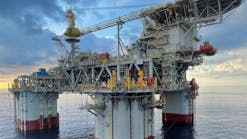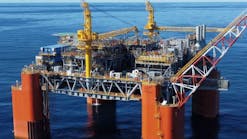U.S. proved reserves of natural gas were up in 1995 for the second year in a row, according to an advance Energy Information Administration report.
EIA said oil and gas discoveries in the federal offshore, including several in deep waters, played a major role as gas reserves posted a 1% gain for the first back-to-back increase in 28 years.
In 1995, a 15% drop in gas prices to an average of $1.59/Mcf at the wellhead followed an 8% price drop the previous year.
EIA said, "The lower prices contributed to the continuation of a long downtrend in overall drilling. Despite this, successful exploratory gas well completions increased 6% to 814. However, development and total gas well completions were down."
It said exploratory oil and total oil well completions increased, as did oil prices. Total discoveries of crude jumped 67% in 1995 to 957 million bbl, their highest level in a decade.
"As a result, although proved oil reserves declined by 0.5%, this was the smallest decline in 8 years. New reservoir discoveries in old fields more than tripled both the 1994 volume and the prior 10-year average for the U.S. At 343 million bbl, these discoveries alone were equivalent to about 15% of the U.S. crude production in 1995."
Gas reserves up
EIA said proved reserves of dry natural gas, those that are economically recoverable using current technology, totaled more than 165 tcf in 1995, continuing the growth of the previous year. The additions brought gas reserves to about 3 tcf above the 1993 total.
EIA said additions to reserves replaced 107% of gas production in 1995. It attributed that to higher revisions and adjustments to reserve estimates of old fields, as well as to gas discoveries (including field extensions, new fields, and new reservoirs in old fields).
"Proved gas reserves continued to increase despite a drop in one important component. Total discoveries were down from their high 1994 level, but still 14% higher than the prior 10-year average." It said more than two thirds of the discoveries were in Texas and the Gulf of Mexico federal offshore, where improved exploration and deepwater production technologies enhanced the ability to discover and develop offshore fields.
Coalbed methane reserves continued to grow, more than replacing the decline of 1994 and accounting for more than 6% of 1995 gas reserves. Coalbed methane production increased to more than 5% of U.S. dry gas production in 1995.
Oil reserves steady
EIA said reserve additions replaced 95% of 1995 oil production, leaving more than 22 billion bbl of proved reserves of crude.
"Although proved reserves of crude oil declined for the eighth consecutive year, the 0.5% decline was the smallest since reserves last increased in 1987."
It said reserve additions from the Gulf of Mexico federal offshore almost single-handedly outweighed the combined proved reserves losses of Alaska, California, and Texas. In addition, the Lower 48 proved reserves of crude increased for the first time in a decade, rising by 81 million bbl.
EIA said that of the 957 million bbl of crude discovered in 1995, the Gulf of Mexico federal offshore accounted for 60%, Texas for 16%, and Alaska for 8%. The Gulf of Mexico federal offshore had 91% of the new reservoir discoveries of crude in old fields.
The full EIA report will be published in November.
Copyright 1996 Oil & Gas Journal. All Rights Reserved.


